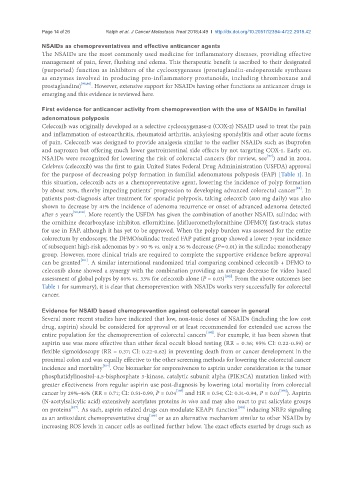Page 594 - Read Online
P. 594
Page 14 of 26 Ralph et al. J Cancer Metastasis Treat 2018;4:49 I http://dx.doi.org/10.20517/2394-4722.2018.42
NSAIDs as chemopreventatives and effective anticancer agents
The NSAIDs are the most commonly used medicine for inflammatory diseases, providing effective
management of pain, fever, flushing and edema. This therapeutic benefit is ascribed to their designated
(purported) function as inhibitors of the cyclooxygenases (prostaglandin-endoperoxide synthases
as enzymes involved in producing pro-inflammatory prostanoids, including thromboxane and
prostaglandins) [95,96] . However, extensive support for NSAIDs having other functions as anticancer drugs is
emerging and this evidence is reviewed here.
First evidence for anticancer activity from chemoprevention with the use of NSAIDs in familial
adenomatous polyposis
Celecoxib was originally developed as a selective cyclooxygenase-2 (COX-2) NSAID used to treat the pain
and inflammation of osteoarthritis, rheumatoid arthritis, ankylosing spondylitis and other acute forms
of pain. Celecoxib was designed to provide analgesia similar to the earlier NSAIDs such as ibuprofen
and naproxen but offering much lower gastrointestinal side effects by not targeting COX-1. Early on,
[97]
NSAIDs were recognized for lowering the risk of colorectal cancers (for review, see ) and in 2004,
Celebrex (celecoxib) was the first to gain United States Federal Drug Admininistration (USFDA) approval
for the purpose of decreasing polyp formation in familial adenomatous polyposis (FAP) [Table 1]. In
this situation, celecoxib acts as a chemopreventative agent, lowering the incidence of polyp formation
[98]
by about 30%, thereby impeding patients’ progression to developing advanced colorectal cancer . In
patients post-diagnosis after treatment for sporadic polyposis, taking celecoxib (400 mg daily) was also
shown to decrease by 41% the incidence of adenoma recurrence or onset of advanced adenoma detected
after 5 years [99,100] . More recently the USFDA has given the combination of another NSAID, sulindac with
the ornithine decarboxylase inhibitor, eflornithine, [difluoromethylornithine (DFMO)] fast-track status
for use in FAP, although it has yet to be approved. When the polyp burden was assessed for the entire
colorectum by endoscopy, the DFMO/sulindac treated FAP patient group showed a lower 3-year incidence
of subsequent high-risk adenomas by > 90 % vs. only a 36 % decrease (P = 0.01) in the sulindac monotherapy
group. However, more clinical trials are required to complete the supportive evidence before approval
[101]
can be granted . A similar international randomized trial comparing combined celecoxib + DFMO to
celecoxib alone showed a synergy with the combination providing an average decrease for video based
[102]
assessment of global polyps by 80% vs. 33% for celecoxib alone (P = 0.03) . From the above outcomes (see
Table 1 for summary), it is clear that chemoprevention with NSAIDs works very successfully for colorectal
cancer.
Evidence for NSAID based chemoprevention against colorectal cancer in general
Several more recent studies have indicated that low, non-toxic doses of NSAIDs (including the low cost
drug, aspirin) should be considered for approval or at least recommended for extended use across the
[103]
entire population for the chemoprevention of colorectal cancers . For example, it has been shown that
aspirin use was more effective than either fecal occult blood testing (RR = 0.36; 95% CI: 0.22-0.59) or
flexible sigmoidoscopy (RR = 0.37; CI: 0.22-0.62) in preventing death from or cancer development in the
proximal colon and was equally effective to the other screening methods for lowering the colorectal cancer
[104]
incidence and mortality . One biomarker for responsiveness to aspirin under consideration is the tumor
phosphatidylinositol-4,5-bisphosphate 3-kinase, catalytic subunit alpha (PIK3CA) mutation linked with
greater effectiveness from regular aspirin use post-diagnosis by lowering total mortality from colorectal
[106]
[105]
cancer by 29%-46% (RR = 0.71; CI: 0.51-0.99, P = 0.04 and HR = 0.54; CI: 0.31-0.94, P = 0.01 ). Aspirin
(N-acetylsalicylic acid) extensively acetylates proteins in vivo and may also react to put salicylate groups
[108]
[107]
on proteins . As such, aspirin related drugs can modulate KEAP1 function inducing NRF2 signaling
[109]
as an antioxidant chemopreventative drug or as an alternative mechanism similar to other NSAIDs by
increasing ROS levels in cancer cells as outlined further below. The exact effects exerted by drugs such as

